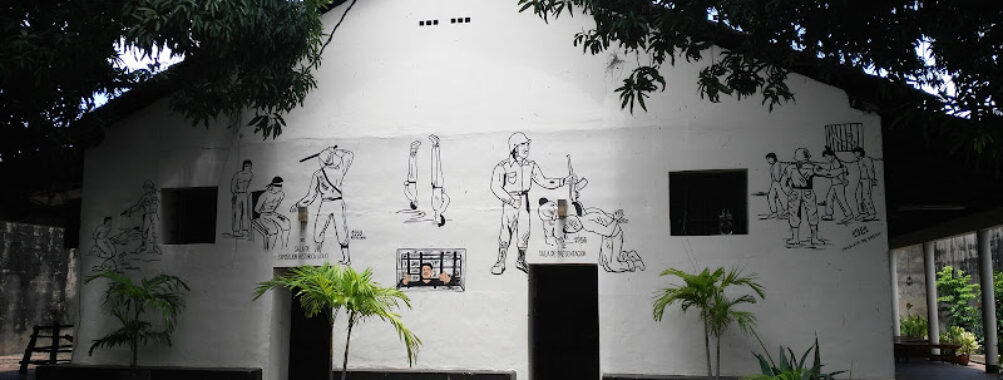
Museum of Traditions and Legends
“`html
Table of Contents
Description
The Museum of Traditions and Legends is not your typical gallery with whitewashed walls and quiet corridors. Housed inside a once-feared prison, the place still carries that heavy atmosphere of history, but it’s softened by color, folklore, and the playful presence of puppets telling the stories of Nicaragua’s past. It’s a curious mix—on one hand, you feel the weight of the building’s darker chapter, and on the other, you’re drawn in by the vibrant folk tales that locals have passed down for generations. Some visitors find this contrast a little unsettling, while others (myself included) think it’s exactly what makes the museum memorable.
The exhibits lean heavily on large handmade puppets, each one representing a legend, a mythical creature, or a character from Nicaragua’s cultural memory. They’re quirky, sometimes a little eerie, but they bring the stories to life in a way that feels more personal than reading them in a book. And honestly, watching kids’ reactions to these giant figures is half the fun—they go from wide-eyed curiosity to giggles pretty quickly. The museum doesn’t try to polish everything to perfection, and in a way, that rawness makes it feel more authentic. You’re getting a slice of real, lived folklore.
It’s not a massive museum where you’ll spend hours wandering, but it does pack in a lot of storytelling. For travelers who enjoy peeling back the layers of a country’s culture, this place offers a refreshing perspective beyond the usual art or history museum. It’s educational, yes, but in a playful, slightly offbeat way. And if you’re a little like me and love places that blend eerie history with cultural charm, you’ll probably end up talking about this visit long after you’ve left.
Key Features
- Located inside a former prison, giving the museum a unique and slightly haunting backdrop
- Exhibits focused on Nicaraguan folklore told through handcrafted puppets and displays
- Family-friendly atmosphere with engaging visuals for children
- Restroom facilities available on-site
- Guided explanations often provided, adding depth to the stories behind each puppet
- A balance of cultural education and entertainment, making it appealing to both locals and travelers
Best Time to Visit
The museum is open year-round, but the best time to go is during the cooler part of the day—usually mornings or later afternoons. Nicaragua’s midday heat can make walking around any site a bit draining, and while the museum is indoors, the building itself doesn’t have the kind of climate control you might expect in larger institutions. If you’re visiting during local festivals or holidays, you might find the place buzzing with more energy, as folklore often takes center stage in celebrations. Personally, I think visiting when it’s quieter adds to the atmosphere—you can almost imagine the whispers of the old prison walls while hearing the legends unfold.
How to Get There
Reaching the Museum of Traditions and Legends is fairly straightforward if you’re already exploring the city. Many travelers choose to walk if they’re staying nearby, as the streets leading to the museum are lined with bits of local life worth observing—street vendors, murals, and the occasional impromptu performance. Taxis are also a reliable option, and they’re relatively inexpensive compared to what you might be used to back home. If you’re the adventurous type, hopping on a local bus is another way to get there, though it does require a bit of patience and a willingness to navigate the somewhat chaotic system. Personally, I enjoy walking because you stumble upon little details you’d miss otherwise.
Tips for Visiting
A few things I wish I’d known before stepping inside: bring water, because even though it’s not a huge museum, the heat can sneak up on you. Wear comfortable shoes too, since the prison’s old floors aren’t exactly forgiving. If you’re traveling with kids, don’t worry—this is one of those rare museums where they’re actually encouraged to engage with the displays (though touching is still off-limits).
Photography is usually allowed, and the puppets make for some pretty fun shots, but remember to be respectful—this was once a place of confinement, and that history still lingers. I’d also recommend chatting with the staff or guides if possible. They often share little anecdotes or explanations that aren’t written on the walls, and those tidbits can really stick with you.
Lastly, keep an open mind. Some people walk away thinking the museum is a bit rough around the edges, while others find it utterly charming. For me, the imperfections are part of the story—it’s a museum that reflects the character of the culture it represents, and that’s far more interesting than a glossy, cookie-cutter attraction. So take your time, let the legends sink in, and maybe even carry a few of them with you as you continue your travels through Nicaragua.
“`
Location
Places to Stay Near Museum of Traditions and Legends
Find and Book a Tour
Explore More Travel Guides
No reviews found! Be the first to review!